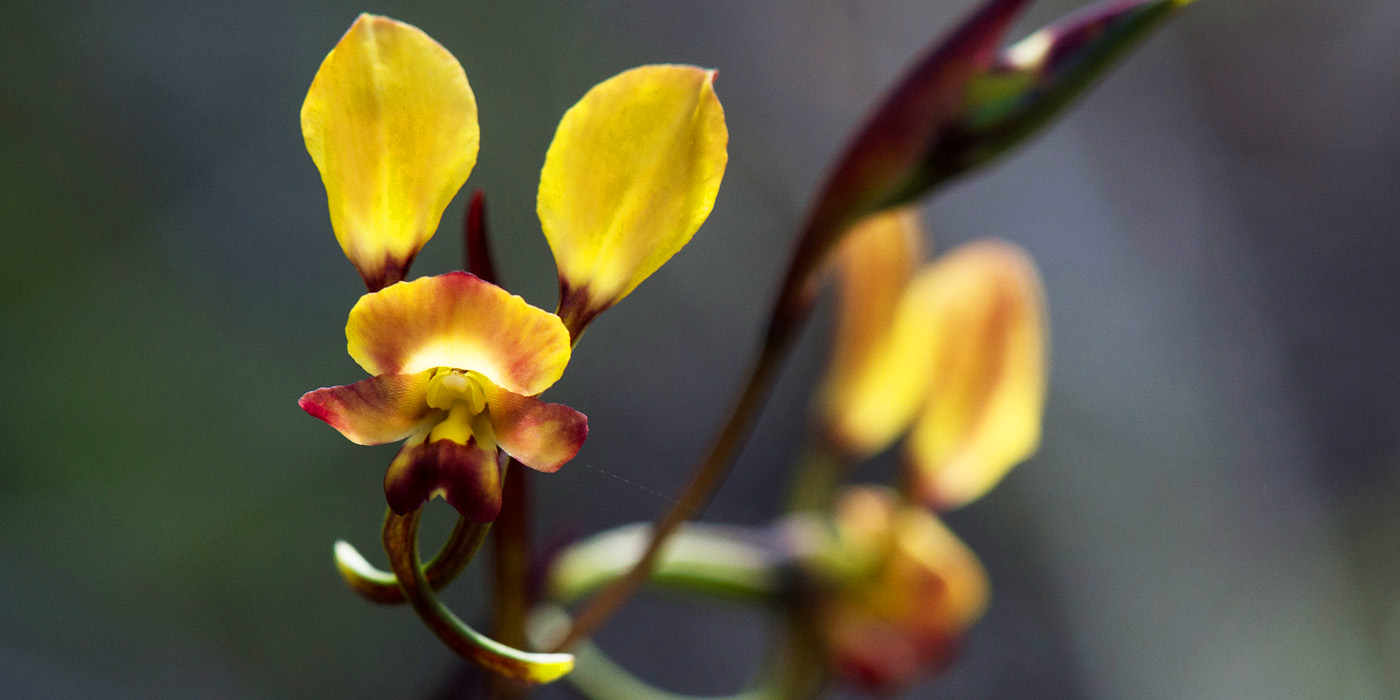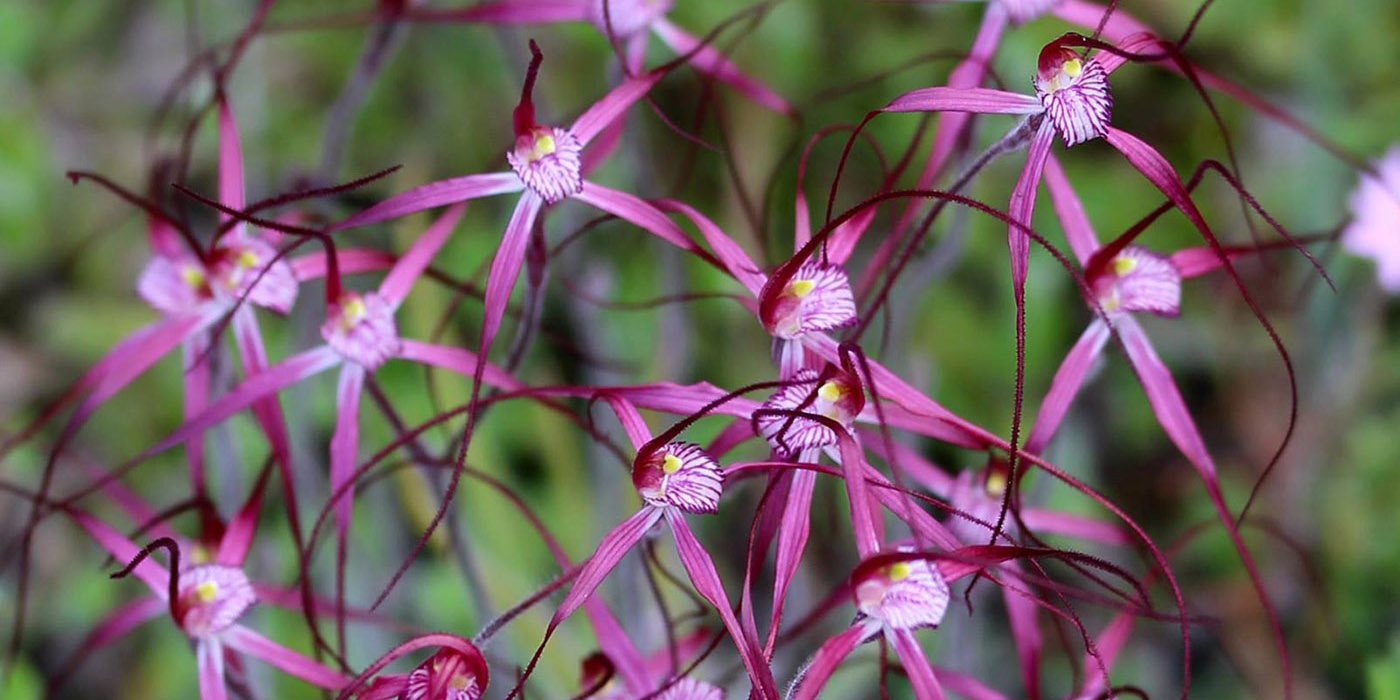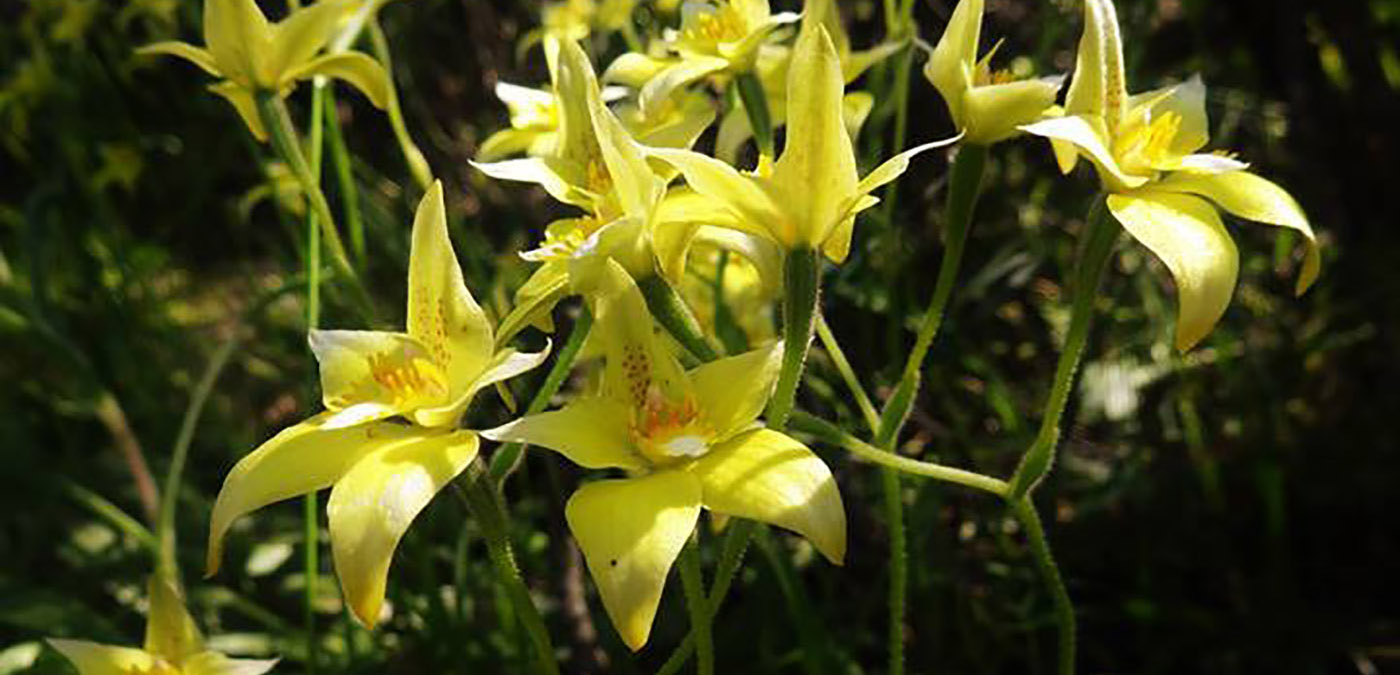Orchids
DONKEY ORCHID
Scientific Name: Diuris
Derived from the Ancient Greek prefix di-, meaning “two” and ouris meaning “tail” referring to the hanging lateral sepals.
Description: Diuris, commonly known as donkey orchids, is a genus of more than sixty species of flowering plants in the orchid family, Orchidaceae and is endemic to Australia apart from one species endemic to Timor. All have mainly yellow flowers with darker markings and are thought to mimic nectar-producing flowers which open at the same time. Orchids in the genus Diuris are terrestrial, perennial, deciduous, sympodial herbs, usually with a few inconspicuous, fine roots and one or two tubers lacking a protective sheath. The stem is short, erect and unbranched with a leaf-like cataphyll at each node. There are between one and ten grass-like leaves at the base of the plant.
Distribution: Donkey orchids occur in all Australian states, but not the Northern Territory with one species (D. fryana) found in Timor. In Western Australia, most grow in moist places such as coastal swamps or near granite outcrops. Donkey orchids usually grow as individual plants or in loose colonies and most occur at low altitudes.
Ecology: Donkey orchids are coloured like flowers that attract pollinating insects such as wasps, bees and flies but no Diuris produce nectar and very few have a scent. It is thought that Diuris species deceive insects by falsely advertising the presence of food.

SPIDER ORCHID
Scientific name: Caladenia, commonly known as spider orchids, is a genus of 350 species of plants in the orchid family, Orchidaceae. Spider orchids are terrestrial herbs with a single hairy leaf and a hairy stem. The labellum is fringed or toothed in most species and there are small projections called calli on the labellum. The flowers have adaptations to attract particular species of insects for pollination. The genus is divided into three groups on the basis of flower shape, broadly, spider orchids, zebra orchids and cowslip orchids, although other common names are often used. Although they occur in other countries, most are Australian and 136 species occur in Western Australia, making it the most species-rich orchid genus in that state.
Description: Orchids in the genus Caladenia are terrestrial, perennial, deciduous, sympodial herbs with a few inconspicuous, fine roots and a tuber partly surrounded by a fibrous sheath. The tuber produces two “droppers” which become daughter tubers in the following year. There is a single hairy convolute leaf at the base of the plant. Unlike the hairs on the leaves of orchids in the similar genus Cyanicula, there is an enlarged cell at the base of each hair. The leaf may be medium-sized to large, fleshy or leathery, lance-shaped to oblong, but is always simple, lacking lobes and serrations. The inflorescence is a raceme with from one to eight resupinate flowers. The three sepals and two petals are free and similar in size and shape to each other. In some species, the sepals or petals or both have narrow tips with club-like ends. As is usual in orchids, one petal is highly modified as the central labellum. The labellum is divided into three parts, each of which usually has a fringed or dentate margin, while the central lobe has stalked or button-like calli which are often in rows. The sexual parts of the flower are fused to the column, which has wing-like structures on its sides. Most species flower in early spring but some species, such as the winter spider orchid (C. drummondii) flower in other months. The fruit that follows flowering is a non-fleshy, dehiscent capsule containing up to 500 seeds.
Distribution: Most caladenias are endemic to Australia. Eleven species, ten of which are endemic, occur in New Zealand with one also occurring in Australia. Caladenia catenata and C. carnea occur in New Caledonia, with the latter also found in Indonesia. There are about 136 species endemic to the south-west of Western Australia, 114 of which have been formally described and a further 18 hybrids which have been described and named. In Western Australia, caladenias are found in the south-west from north of Kalbarri on the west coast to the Nuytsland Nature Reserve on the coast of the Great Australian Bight. Their habitats range from cool, moist Karri forest, to swamplands near the coast and to almost arid mallee woodland.

COWSLIP ORCHID
Scientific Name: Caladenia flava
Caladenia flava, commonly known as cowslip orchid, is a species of orchid endemic to the south-west of Western Australia. It is a relatively common orchid with a single, hairy leaf and up to three yellow flowers which often have red markings. In 2001 three subspecies were named and a fourth is recognised but not as yet formally described.
Description: Caladenia flava is a perennial herb, which grows from underground stems. The leaf and flowerstalk appear from these to present several yellow flowers during July – December. The leaf is long for the species size, becoming narrower beyond the middle. Flowers are on a long stalk and are between two and five, usually yellow, occasionally pinkish or white, and speckled with magenta. Sepals and petals are broad though long, tapering to a point, and contracted at the base. Lateral sepals may be over 2–3 mm long, the upper sepal is smaller, with a reddish line of splotches along the centre. The flower has a lip over 5 mm with a small claw-shaped structure, three lobes are nearly separate, lateral lobes are ovate, the middle lobe longer and slightly broad, bordered on each side by several long structures (calli). These calli are in two rows, almost a semicircle. A column structure is present, and is winged from the base.
Distribution: Cowslip orchid is common in the Southwest, growing in a range of soil types including laterite and granite. It often occurs with burnt trees, especially marri and is found in winter wet areas, forest, coastal woodlands, and on granite outcrops throughout the Southwest and Eremaean botanical provinces.
